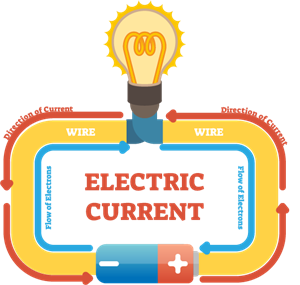PDF chapter test TRY NOW
In modern society, it is not easy to lead our life without electricity. Without electricity, most of our daily activities would come to a halt. Electricity is one of the important sources of energy that are generated from power stations.

Power station
An electric current is generally defined as the flow of electric charges. In other words, moving electrons generate an electric current.

Flow of electric current in a circuit
Source of Electric current:
Electric cell:An 'electric cell' is a device that converts chemical energy into electrical energy, thus producing a small amount of electricity. A cell is a single unit.

A cell
Battery:
A battery is a collection of two or more cells. It is the main source of electric current.
A battery is a collection of two or more cells. It is the main source of electric current.

Battery
Symbol for cell and battery:
In an electric circuit, the positive terminal represents a longer line, and the negative terminal represents a shorter line.
In an electric circuit, the positive terminal represents a longer line, and the negative terminal represents a shorter line.

Schematic representation of Cell and Battery
Direction of current:
When a conducting path is provided to a charged object, electrons flow through the path from a higher to a lower potential zone. Normally, a cell or battery generates this potential difference.Important!
Before discovering electrons, scientists thought that an electric current was made up of moving positive charges. Although this is incorrect, the belief continues because the discovery of electron flow has no impact on our basic understanding of electric current.
Conventional current and Electron current:
The movement of the positive charges or protons constitutes the conventional current whereas, the movement of the negative charges or electrons constitutes the electron current.

The direction of conventional current
The flow of negatively charged electrons is always opposite to the direction of protons. Hence, the direction of conventional current is always opposite to the direction of electron current.
The conventional current moves from the positive terminal to the negative terminal of the battery. At the same time, the electron current (negative charge) moves from the negative terminal to the positive terminal of the battery.

The direction of electron current
The direction of electrons makes the electric current move from the positive terminal to the negative terminal of the circuit.
